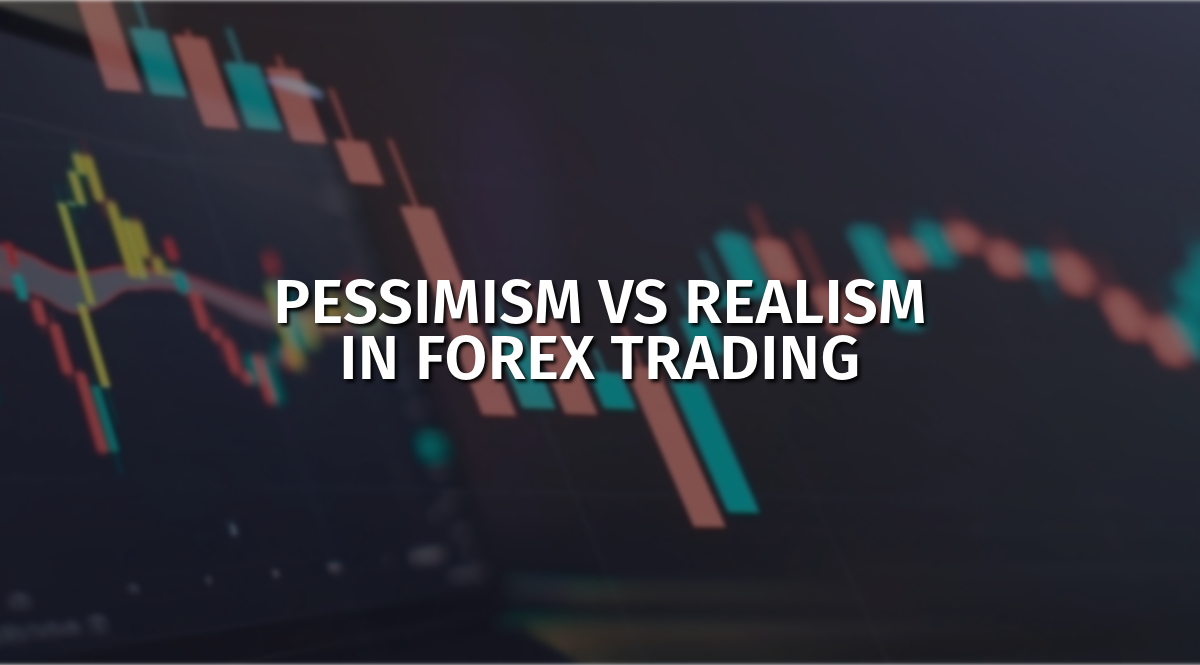Pessimism vs realism in Forex trading
In the world of Forex trading, your mindset can make or break your success. It’s a delicate balancing act between pessimism vs realism i.s. pessimism vs optimism. While these mental states affect your trading decisions, understanding their impact is crucial for developing a successful trading strategy.
The Pitfalls of Pessimism in Trading
Pessimism in trading often stems from a fear of losses or negative experiences with losing trades. It’s easy to fall into this trap, especially after a few bad runs.
But here’s the thing – excessive pessimism can cloud your judgment. It can lead to missing out on potential opportunities because you’re too focused on what could go wrong. This fear and greed cycle can be a major psychological barrier to successful trading.
Pessimism often arises from negative thoughts and a fear of losses. It’s a protective mechanism – if you expect the worst, you won’t be disappointed.
However, in Forex trading, excessive pessimism can hinder success. It leads to a heightened fear of risk, causing traders to miss out on potentially lucrative opportunities.
Pessimism can transform a cautious trader into a paralyzed one, unable to make any trading decisions.
Embracing Realism in Your Trading Strategy
So, what’s the alternative? Realism. This doesn’t mean ignoring the risks; it means acknowledging them and incorporating them into your trading plan.
Realistic Forex Strategies involve a thorough understanding of market sentiment and technical analysis. It’s about making investment decisions based on data and trends, not just gut feelings or fear.
Realism in Forex trading is about acknowledging the risks without being overwhelmed by them. It involves a comprehensive understanding of Forex markets and basing decisions on thorough market sentiment analysis and technical analysis.
Realistic traders develop a trading strategy that includes clear goals and risk management techniques like setting appropriate stop losses.
Optimists vs pessimists in Forex trading
When it comes to Forex trading, you’ve got two kinds of people – the optimists and the pessimists. Now, the optimists are the ones who see the glass as half full.
They’re always looking for opportunities, even in a downward-trending market. Pessimists, on the other hand, are more like the ‘prepare for the worst’ kind. They’re cautious, maybe even a bit too cautious, always on the lookout for what could go wrong.
But here’s the thing – Forex trading needs a bit of both. You need the optimism to jump on opportunities but also a sprinkle of pessimism to keep your risk in check.
Pessimism vs Realism in Forex: Navigating the Emotional Terrain
Let’s not forget the role emotions play in trading. Emotional trading impacts decision-making processes. It often leads to impulsive actions like deviating from your trading strategy or moving your stop losses. Successful traders know how to manage these emotions, keeping a level head through both the highs and lows.
Qualities of Optimistic Investors
Understand that not every option will be successful, but also believe not all will fail.
Eager to learn from mistakes and grow through hands-on experience, which they see as better than staying out of the game like strong pessimists.
Less likely to give up after setbacks, viewing each situation as a chance to learn, not as a win-or-lose battle.
Qualities of Pessimistic Investors
Might quit a successful investment to avoid negative feelings, even when chances are good.
Very cautious and detail-oriented, wanting to know every step of an investment before committing. This approach makes them slower to act in fast-moving markets, leading to missed opportunities compared to optimistic investors.
Depend too much on historical data, often hesitant to invest in a rising market if the future is uncertain.
Prone to stress from losses, as they expect to profit from every investment.
Prefer acting on complete information, unwilling to enter ventures without a full understanding of what’s involved.
Creating a Balanced Trading Approach
Achieving a balanced trading approach is key. This involves a blend of Forex Trading Psychology and Risk Management in Forex.
It’s recognizing the psychological trading barriers you might face and having a plan to overcome them. Your bottom line in Forex trading isn’t just about the profits you make; it’s also about how well you manage your mental states and stay true to your trading plan.
Remember, in Forex trading, long-term success doesn’t come from being overly pessimistic or unrealistically optimistic.
It comes from a balanced, realistic approach that considers the complexities of the Forex market realities and prepares you for whatever the market throws your way.
So, as you chart your path in the Forex markets, ask yourself: are you leaning more towards pessimism or practicing realism in your trading decisions? The answer could be the key to your success in Forex trading.
Understanding the Mindset in Forex Trading
Forex trading is not just about charts and numbers; it’s equally about the trader’s mindset. Traders often find themselves on a spectrum between pessimism and realism.
Understanding these mental states is crucial in navigating the Forex markets successfully.
Emotions play a significant role in trading. Emotional trading can lead to impulsive decisions, such as straying from your trading plan or improperly moving stop losses.
It’s essential to recognize these emotional responses and their impact on your trading decisions. Successful traders maintain a level head, managing their emotions effectively through both profitable and losing trades.
Forex Trading Psychology: Balancing Fear and Greed
Forex trading psychology revolves around managing two primary emotions: fear and greed. Fear can lead to closing positions too early or not taking trades at all, while greed can result in overtrading or holding onto losing positions for too long. Balancing these emotions is critical for long-term success in Forex trading.
Developing a Realistic Trading Plan
A realistic trading plan is more than a set of entry and exit rules. It’s a comprehensive strategy that includes understanding the market realities, setting achievable goals, and incorporating effective risk management.
This plan should be flexible enough to adapt to changing market conditions while remaining robust enough to keep you grounded in your trading principles.
Learning from Losing Trades
In Forex, losing trades is inevitable. How traders respond to these losses is what differentiates pessimism from realism.
Pessimists might view losses as a sign of failure, while realists see them as learning opportunities. Analyzing why a trade didn’t work out can provide valuable insights for future strategies.
The Role of Market Sentiment Analysis
Market sentiment analysis is a vital tool for realistic traders. It involves gauging the mood of the market to predict future currency movements. Understanding market sentiment helps in making informed trading decisions rather than ones based purely on emotional reactions.
Risk Management: The Foundation of Forex Success
Effective risk management is a cornerstone of successful Forex trading. It involves not only setting stop loss orders but also understanding leverage and its implications. Realistic traders use risk management to protect their capital and stay in the game for the long term.
Overcoming Psychological Trading Barriers:
Psychological barriers in contrast to Pessimism vs realism, such as the fear of missing out (FOMO) or the inability to cut losses, can hinder trading success. Overcoming these barriers requires self-awareness, discipline, and a commitment to your trading plan.
The bottom line in Forex trading isn’t determined solely by the profits or losses on a trade. It’s also about how effectively you manage your mental states and stick to your trading principles.
Balancing pessimism and realism is essential in making sound trading decisions and achieving long-term success in the Forex market.
In conclusion, the journey of a Forex trader is as much about managing emotions and mindset as it is about understanding the markets.
Striking the right balance between pessimism and realism can lead to more thoughtful, informed, and ultimately successful trading decisions. As you navigate the Forex market, remember that your greatest asset is a balanced, realistic approach to trading.
Do optimists make more money?
So, do the optimists end up making more money? Well, it’s not that straightforward. Sure, optimists might jump into trades that pessimists would shy away from, which can lead to big wins. But this can also backfire if they’re not careful.
Optimists might overlook the risks or hold onto losing trades, hoping things will turn around. It’s all about finding that sweet spot – being optimistic enough to take calculated risks, but not so much that you throw caution to the wind.
How can investor optimism or pessimism affect stock prices?
Investor optimism or pessimism can really sway stock prices. When a bunch of traders are optimistic about a currency or a market, they start buying, which pushes the prices up.
It’s like a self-fulfilling prophecy – the more people believe a currency will strengthen, the more it actually does. But the opposite is true too. If traders get pessimistic, maybe because of some bad economic news or political drama, they start selling off.
And when everyone’s selling, prices drop. This herd mentality can lead to big market swings, based just on what traders feel might happen.
Conclusion – Pessimism vs realism in Forex trading
In the end, whether you’re an optimist , pessimist, or a simple realist, the key in Forex trading is to back up those feelings with solid analysis and a robust trading plan.
Don’t just trade on a hunch – whether that’s a rosy or gloomy one. Keep your emotions in check, use your head, and you might just find yourself on the winning side more often than not.
The post Pessimism vs realism in Forex trading appeared first on FinanceBrokerage.

































